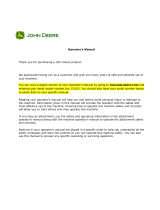8999146EN: v1 26/02/2020
6
Original instructions (ENGLISH)
Website: www.spearheadmachinery.com
Contents List
1 Machine Description ............................................................................................................................... 8
1.1 Intended Usage. ........................................................................................................................ 8
1.2 General Arrangement ............................................................................................................... 9
1.3 Machine General Specification. ................................................................................................ 9
1.4 Machine Identification ............................................................................................................. 10
2 Safety .................................................................................................................................................... 12
2.1 Safety Warnings ...................................................................................................................... 12
2.2 Emergency Stop ...................................................................................................................... 13
2.3 Dangers Due To Overhead Power Lines ............................................................................... 13
2.3.1 Risk Assessment ....................................................................................................... 14
2.3.2 Emergency Action for Accidents Involving Electricity ............................................... 14
2.4 Noise ....................................................................................................................................... 16
2.5 Personal Protective Equipment .............................................................................................. 16
2.6 Cab Guarding .......................................................................................................................... 16
2.7 Stability .................................................................................................................................... 17
2.8 Working On Inclined Ground................................................................................................... 18
2.9 Working On Embankments ..................................................................................................... 18
2.10 Attachment And Removal From The Reach Arm ................................................................... 18
2.11 Working In Public Places ........................................................................................................ 19
2.12 Safe Maintenance ................................................................................................................... 19
2.13 Safety Distances ..................................................................................................................... 21
2.14 Warning Signs ......................................................................................................................... 21
2.14.1 Suggested Warning Signs Required ......................................................................... 21
2.14.2 Use of Warning Signs ................................................................................................ 21
2.15 Safety Decals .......................................................................................................................... 22
2.16 The Machine & The Environment ........................................................................................... 23
2.16.1 Disposal ..................................................................................................................... 23
2.17 Proposition 65 ......................................................................................................................... 24
3 Machine Preparation............................................................................................................................. 26
3.1 Tractor Requirements; ............................................................................................................ 26
3.2 Tractor Checks ........................................................................................................................ 26
3.3 Lifting The Machine ................................................................................................................. 26
3.3.1 Lifting Equipment ....................................................................................................... 26
3.3.2 Lifting Points .............................................................................................................. 26
3.4 Controls Overview ................................................................................................................... 27
3.5 Machine Attachment ............................................................................................................... 27
3.5.1 Blade Guard............................................................................................................... 27
3.6 Attaching To The Reach Arm ................................................................................................. 28
3.7 Blade Cutting Direction ........................................................................................................... 29
3.8 Hydraulic Installation ............................................................................................................... 29
3.9 Hydraulic Hose Checks ........................................................................................................... 30
3.9.1 Twists ......................................................................................................................... 30
3.9.2 Sharp Bends .............................................................................................................. 31
3.9.3 Chafing Hoses ........................................................................................................... 32
4 Usage Instruction .................................................................................................................................. 34
4.1 Operator Requirements .......................................................................................................... 34
4.1.1 Personal Protection Equipment (PPE) ...................................................................... 34
4.2 Work Site Assessment ............................................................................................................ 35
4.2.1 Foreign Debris Hazards ............................................................................................ 35
4.2.2 Bystanders ................................................................................................................. 36
4.2.3 Weather ..................................................................................................................... 36
4.2.4 Fire ............................................................................................................................. 36
4.3 Using The Sawblade ............................................................................................................... 36
4.4 Beginning Work ....................................................................................................................... 39
4.4.1 Pre-start Checks ........................................................................................................ 39
4.4.2 Starting The Sawblade .............................................................................................. 39
4.4.3 Stopping The Sawblade ............................................................................................ 39
4.4.4 Stopping The Machine In An Emergency ................................................................. 40
4.5 General Cutting Hints .............................................................................................................. 40
4.5.2 Hedge Cutting Hints .................................................................................................. 40

























